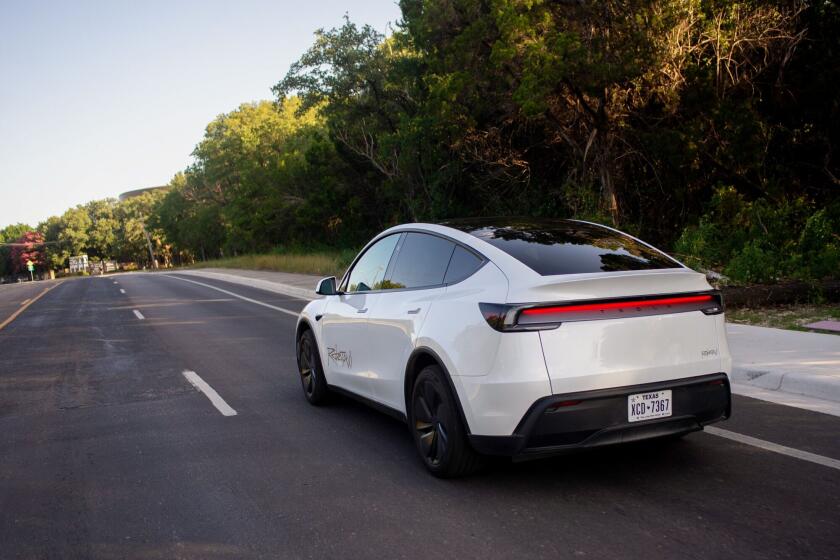Pedestrians Should Take a Walk on the Safer Side of the Street
- Share via
Dear Street Smart:
When walking on roadways, why do 90% of pedestrians risk their lives (and violate the California Vehicle Code) by walking with the traffic instead of facing oncoming traffic? Even schoolteachers lead their students on the wrong side of the street in exercises. Facing the traffic provides a chance to dodge inattentive drivers and cyclists. An education program would reduce the casualty rate in pedestrians.
Keith Conroy
Dana Point
You’re right, California Vehicle Code Section 21956 requires pedestrians to walk against oncoming traffic when there are no sidewalks.
Although the California Highway Patrol doesn’t put a high priority on enforcing that law, spokeswoman Sandra Houston said, its officers still preach it regularly when speaking to schoolchildren.
“It’s so that people can see oncoming cars,” Houston said. “If you can seem them coming, you might have time to take some evasive action.”
Paul Snodgrass, a highway safety specialist for the National Highway Traffic Safety Administration, sees it differently, however. The idea of walking against traffic, he says, is “an old country adage” stemming from a time when the nation was much more rural and crisscrossed with country roads featuring far fewer cars and a lot more pedestrians.
“I’m not disagreeing with the practice,” he said, “except that it’s a very old-fashioned answer and there are better answers available.”
The one he favors: building more sidewalks so that the direction in which one walks is no longer an issue. “Pedestrians really should be separated from the traffic,” Snodgrass said. “They shouldn’t have to be dodging speeding cars.”
The federal government, working with a private group called Partnership for a Walkable America, just started a program offering “pedestrian road shows” during which representatives will visit a city for two days to examine its pedestrian friendliness and make recommendations on improving it. Some federal money is available for that purpose, Snodgrass said.
“Traffic engineering has traditionally emphasized moving the maximum volume of cars through a given area while ignoring the needs of pedestrians,” he said.
Dear Street Smart:
I’m a 19-year-old Orange County resident who commutes 100 miles or so, five days a week from 9 p.m. to 4 a.m. I drive a Honda Civic that has been lowered 2.5 inches. Here’s my question: Is there anything illegal about driving a lowered car? I’ve heard stories from friends that they were pulled over, got fix-it tickets and had to redo the suspension to stock specifications, a very expensive remedy.
S. Smith
Fountain Valley
The California Vehicle Code does specify minimum clearance requirements for cars. According to Section 24008, it is illegal to drive one modified to the extent that any of its nonrubber parts are closer to the pavement than the lowest part of its rim, the metal portion of the wheel.
Dear Street Smart:
I was involved in an accident last year and have a question about lane changes. I was turning right against a red light onto Beach Boulevard. The lane I wanted to enter was the far-right lane, closest to the curb. There were cars in the other lanes, but this lane was available so I proceeded with my turn. Immediately after completing my turn, a truck changed lanes into me.
I was eventually considered not at fault, but initially there was some controversy surrounding this accident. The conclusion was made that this other vehicle executed his lane change in the middle of the intersection and ultimately hit me.
My question is: Is there any law that prevents a person from making a lane change in an intersection? If so, how much distance prior to the intersection and afterward must one travel before they can execute a lane change?
Patti Harris
Rossmoor
There is nothing in the vehicle code prohibiting a driver from changing lanes in the middle of an intersection. The code does, however, require drivers to refrain from changing lanes unless they can do so with “reasonable safety.” Apparently, it was determined that the truck driver who hit you had changed lanes dangerously.
“It would have been unsafe,” Houston theorized, “because he traversed the lane when somebody was already there. This is one of those things where there’s always some wiggle room for interpretation.”
Street Smart appears Mondays in The Times Orange County Edition. Readers are invited to submit comments and questions about traffic, commuting and what makes it difficult to get around in Orange County. Include simple sketches if helpful. Letters may be published in upcoming columns. Please write to David Haldane, c/o Street Smart, The Times Orange County Edition, P.O. Box 2008, Costa Mesa, CA 92626, send faxes to (714) 966-7711 or e-mail him at David.Haldane@latimes.com. Include your full name, address and day and evening phone numbers. Letters may be edited, and no anonymous letters will be accepted.
More to Read
Sign up for Essential California
The most important California stories and recommendations in your inbox every morning.
You may occasionally receive promotional content from the Los Angeles Times.













